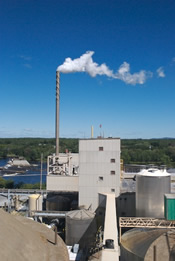UMaine Biofuels Development Supports Existing Pulp Mill

In an innovative process that literally involves “cooking,” the University of Maine has become a kitchen where research and business ingredients are creating a biorefinery model to add value to Maine’s pulp and paper mills while also creating biofuels and bioproducts. Maine’s abundant forest resources, landowners seeking markets for low grade wood, mill communities in economic decline, and UMaine researchers eager to create new biofuels and bioproducts are making progress to assemble a viable biorefinery that addresses all these challenges.
UMaine’s proprietary “van Heiningen process” for hemicellulose extraction from woodchips prior to pulping is moving towards technology deployment at the Red Shield pulp mill, located two miles from its laboratories. Grants from the Department of Energy on its Industries of the Future (IoF) program, the National Science Foundation’s EPSCoR program, and International Paper support efforts to separate and recombine wood fibers in ways that allow diverse products to be created at one location. Products like fuels, energy, chemicals and polymers would support existing pulp production at mills that are currently struggling to remain competitive.
In the fall of 2007, UMaine researchers Peter van Walsum, Adriaan van Heiningen, and Sara Walton made progress fermenting wood extracts into ethanol despite higher concentrations of chemical “inhibitors”. (These inhibiting dissolved solids, acids, and sodium salts are time consuming and costly to remove.) Any reduction in treatment procedures is good news for a research process working to scale ethanol making systems from small amounts in the laboratory to the larger amounts of wood extract (hemicelluloses) needed for industrial production of ethanol.
Researchers also discovered that bacteria (necessary to ferment wood extracts into ethanol….much like bacteria ferments beer) may also adapt and remain productive without as much post extractive reduction of these same inhibitors. The research goal is to make the most amount of ethanol with the fewest steps possible. UMaine’s current research progress also includes research to extract inhibitors like acetic acid (essentially vinegar) and offer it as another saleable bioproduct .
During December 2007, Red Shield Pulp and Chemicals (in Old Town, Maine) began preparing its mill to use the “van Heiningen process.” The mill converted its existing one-vessel pulping system into a two-vessel system able to accommodate both production of pulp and the extraction of hemicellulose from wood chips. The extracted hemicellulose fibers are necessary to provide a new feedstock for ethanol production. These vessels now function like two pressure cookers piped together to allow various ingredients to flow in several different directions. Wood chips are fed into the first vessel used for extraction and sluiced into the second (pulp producing) vessel. Later they will supply the hemicelluloses-rich extract stream for the ethanol production process. Mill engineers are expecting that final work to define the needed chemistry to efficiently divert extract from woodchips into ethanol production will also be part of a pioneering process to design an integrated forest products refinery at the mill site. Ongoing UMaine research that carefully characterizes the conversion and fermentation process will be part of the design specifications for a proposed satellite plant capable of producing two million gallons of ethanol per year.
